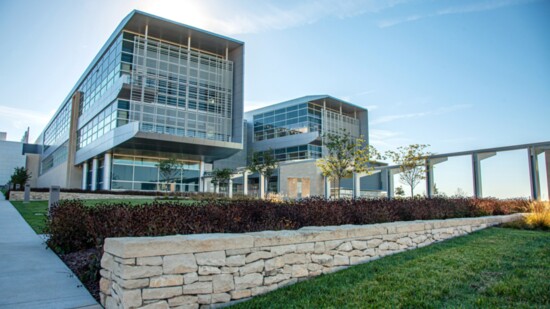Standing on a verdant 48-acre site near K-State’s campus, the National Bio and Agro-Defense Facility’s serene setting belies its critical mission: to protect the United States against animal diseases that threaten our food supply and public health. Opened in 2023, NBAF is a cutting-edge research facility tasked with preventing outbreaks before they occur.
At the helm of NBAF is Dr. Alfonso Clavijo, an accomplished researcher and public health leader in the fields of diagnostic virology and infectious animal diseases. A native of Colombia, he was recruited to build the first program to diagnose and manage foot-and-mouth disease in Canada. He later expanded his work to include emerging zoonotic diseases, such as rabies, which can spread from animals to humans.
As the Director of NBAF, Dr. Clavijo oversees a growing team of scientists and engineers dedicated to NBAF’s mission. “We have about 300 people here now, and we will grow to more than 400, including both scientists and operations staff,” he says. “The level of responsibility we have is enormous. We want to make sure that nothing from inside gets out, and that we are able to diagnose, research, and train effectively to protect the country.”
Owned and operated by the U.S. Department of Agriculture (USDA), NBAF brings together two key agencies to tackle this mission: the Animal and Plant Health Inspection Service (APHIS) and the Agricultural Research Service (ARS). APHIS focuses on diagnostics, training, and emergency response, while ARS leads research and development efforts to find solutions, such as vaccines, that can prevent or contain outbreaks.
Dr. Clavijo emphasizes the importance of this collaboration. “We are fortunate to have both agencies working here. It’s a complementary relationship, combining research with practical application,” he says. This partnership allows NBAF to address animal and public health threats from multiple angles, which improves the country’s ability to respond to potential crises.
The facility aims to understand the epidemiology of emerging diseases and how they affect both animals and humans. By studying the patterns of disease transmission, NBAF scientists can identify high-risk areas and develop innovative strategies to prevent the spread of these diseases. These efforts are supported by the use of artificial intelligence and bioinformatics to predict and track disease outbreaks in real-time.
NBAF holds the distinction of being the first facility in the country with Biosafety Level 4 capabilities for large livestock. These labs are designed to prevent any chance of exposure to pathogens, ensuring maximum safety for the public. Their safety features include airtight rooms, specialized ventilation systems, and rigorous procedures for anyone leaving the labs. Dr. Clavijo emphasizes that all staff members undergo extensive training to ensure they are fully prepared to work in such a complex environment.
While NBAF’s primary focus is to protect U.S. agriculture, it is committed to engaging with the Manhattan community. Dr. Clavijo recognizes the importance of transparency and building trust with the public, especially given the complex nature of the work conducted at the facility. He emphasizes that the facility’s work is not classified, and the work conducted at NBAF is published in scientific journals and shared at conferences. "Our mission is for the public good, and we want to be as transparent as possible," he explains.
Many stakeholders have been invited to visit the facility, including the containment spaces, before the facility becomes fully operational. These tours are an opportunity to see firsthand the safety measures in place and meet the scientists and staff who are working to protect the country. “We want our stakeholders and the community to know they are welcome to ask questions and share any concerns they might have,” says Dr. Clavijo.
Through engaging with students at science fairs, summer STEM programs, and other initiatives, NBAF seeks to inspire the next generation of scientists. “We want young people to see that the work scientists do has a real impact,” Dr. Clavijo explains. Through outreach efforts, NBAF aims to show students that careers in biosecurity, research, diagnostics and animal health are accessible. Dr. Clavijo encourages young people interested in potentially working in the fields of biosecurity or agro-defense to foster their curiosity and persistence. "Don’t be afraid to look beyond what you know. Ask questions and keep that curiosity alive. Find a mentor who can guide you in the right direction."
Looking ahead, Dr. Clavijo is optimistic about the future of NBAF due to its people. "We are already part of the future. The facility will evolve, but the real impact is in the people we are developing here—the scientists, engineers, and experts who will protect the country from emerging diseases," he says. "We are building a team that will continue to push the boundaries of science and technology to keep our country safe."
